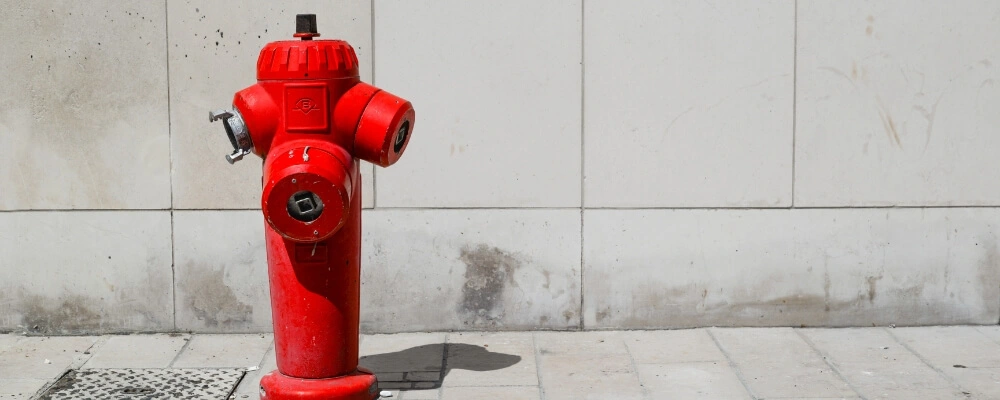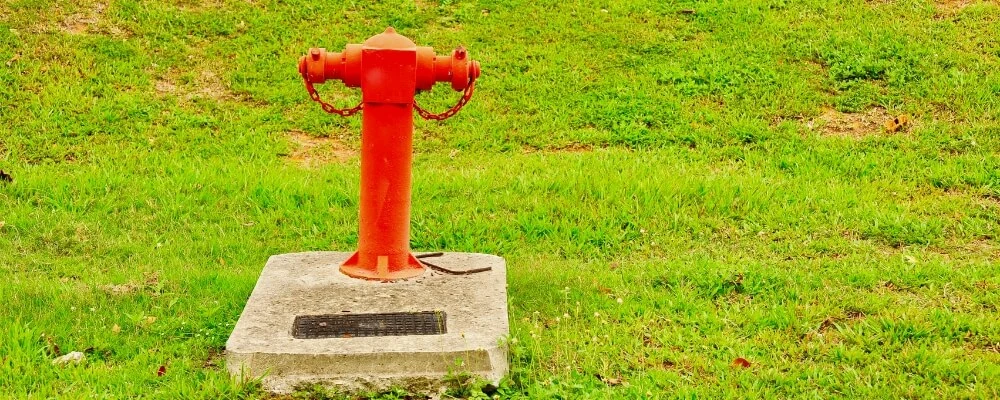DIFFERENT COMPONENTS OF THE FIRE HYDRANT SYSTEM
An elaborate configuration of parts called a fire hydrant system is intended to supply enough water for combating fires. Below is a thorough explanation of the many parts that normally make up a fire hydrant system:
- Fire hydrants: The most noticeable components of the system are the fire hydrants, which give firefighters an exterior connecting point to the water supply. As was previously said, they can be of many different kinds, including pillar hydrants, wet barrels, and dry barrels.
- Water Supply Source: The main source, or reservoir, from which the water for the hydrant system is obtained. It might be directly connected to the city’s water supply, a specialized water tank, or a natural water source like a lake or river.
- Pumping System: A pumping system is used to make sure that water is delivered to the hydrants at a sufficient pressure. One or more high-capacity pumps that can move water quickly through the system, particularly over large distances or to significant heights in high-rise buildings, usually make up this.
- Distributable Pipework: Water is transported from the source to different hydrants via a network of above-ground or subterranean pipes known as the distribution pipework. These pipes must be long-lasting and impervious to environmental elements like corrosion.
- Valves: Essential parts that control the system’s water flow are valves. They can be used to regulate water flow during firefighting operations or to isolate specific areas of the network for maintenance. Hydrant systems frequently use gate valves and butterfly valves.
- Hose Reels and Hoses: Hose reels, which are frequently located next to hydrants, give firemen quick access to hoses. These hoses are made especially to be strong, flexible, and resistant to high pressure.
- Fire Brigade Inlets (or Collecting Heads): Fire Brigade Inlets, also known as Collecting Heads, are connections that let firemen use their fire vehicles to pump water into the system, enhancing the current water supply—which is particularly useful if it’s insufficient during a big fire.
- Pressure Gauges: These are devices that keep an eye on the system’s pressure to make sure it stays within operational and safe bounds. Operators might be informed about possible problems or obstructions by routine monitoring.
- Post-Indicator Valve (PIV): A visual indicator of whether a valve is open or closed is provided by the post-indicator valve (PIV). It is particularly helpful for systems that are linked to buildings’ automated fire sprinkler systems.
- Drain Points: These are carefully positioned spots throughout the system that let water drain. They are crucial for testing, maintenance, and avoiding freezing in colder areas.
- Risers: Risers are vertical pipes used in multistory buildings that are intended to move water upward. In order to provide hose connection sites, they may also have landing valves on different floors.
Every one of these elements is essential to maintaining the fire hydrant system’s overall dependability and effectiveness. Maintaining optimal functioning of every component and ensuring emergency preparedness of the system require routine inspections and maintenance.

FIRE HYDRANTS COLOUR CODING
Important details regarding the pressure and flow rate of the water supply are provided by the color coding of fire hydrants. It facilitates firefighters’ rapid decision-making on the use of fire hydrants, particularly during crises. Different countries and even regions within the same country may use different color coding. However, the broad summary that follows is based on the National Fire Protection Association (NFPA) standards that are applied throughout the United States:
- Red: A fire hydrant with a water flow of fewer than 500 gallons per minute (GPM) is usually indicated by this color. It may not be adequate for commercial or industrial firefighting needs, but it is deemed appropriate for basic residential regions.
- Orange: A 500–999 GPM flow rate is indicated by an orange fire hydrant. There are numerous applications for this moderate flow rate in firefighting.
- Green: A flow rate between 1000 and 1499 GPM is indicated by green hydrants. Most business locations as well as most firefighting demands can be served by these hydrants.
- Blue: A flow rate of at least 1500 GPM is indicated by the color blue. A strong water supply is offered by these hydrants, making them appropriate for major fires or industrial settings.
- Caps & Bonnets: In addition to the main body, hydrants can have color-coded bonnets and caps. They could provide further details regarding the particular features of the fire hydrant or point out alternative water sources, such as non-potable water sources.
- Other colors: In some places, hydrants’ basic color may be yellow or white, with the caps painted in one of the traditional hues to denote flow rate. Other colors are occasionally used for specific objectives. A purple fire hydrant, for instance, maybe a sign that the water source is reclaimed or non-potable.
- Reflective Markers: To improve firefighter safety and accessibility at night, several jurisdictions also utilize reflective markers or bands on hydrants.
It is imperative for municipal fire departments and water authorities to uphold a uniform color-coding scheme and guarantee that all pertinent staff members are adequately trained to identify and comprehend the meaning behind the colors. Furthermore, companies and locals should be made aware that painting fire hydrants in a different color without permission can confuse firemen in an emergency.

CODES AND STANDARDS OF FIRE HYDRANTS
Many laws and standards regulate fire hydrants and the systems that are connected to them in order to guarantee their dependable operation in an emergency. The requirements for design, installation, testing, and maintenance are outlined in these regulations and standards. Accredited organizations install them to make sure fire hydrants work as designed and supply firemen with the water they need.
1. National Fire Protection Association (NFPA)
- NFPA 24: The “Standard for the Installation of Private Fire Service Mains and Their Appurtenances,” or NFPA 24, offers instructions on how to install private hydrants, fire service main pipework, and other items.
- NFPA 291: Also known as the “Recommended Practise for Fire Flow Testing and Marking of Hydrants,” this standard offers instructions for conducting fire flow testing and color-coding hydrants to show the range of flow that each one can handle.
2. American Water Works Association (AWWA)
- AWWA C502: The “Dry-Barrel Fire Hydrants” standard sets minimum specifications for fire hydrants that are utilised in water delivery services.
- AWWA C550: This standard guarantees durability and safety with regard to protective epoxy interior coatings for valves and hydrants.
- International Building Code (IBC): This is an extensive, globally used architectural code that covers everything from fire hydrant placement to other pertinent fire safety details.
3. International Fire Code (IFC)
This code includes information on fire hydrants as well as general fire prevention rules and fire safety specifications for both new and old structures, storage, and operations.
4. State and Local Codes
Certain states or local municipalities may have extra requirements or adjustments for fire hydrant systems in addition to international and national norms. These could have to do with things like the minimum spacing between fire hydrants, the flow rates needed in a given location depending on the kind of structures there, or particular upkeep procedures.
5. Factory Mutual (FM) Global
FM, or Factory Mutual A significant global insurer of business and industrial buildings, Global FM has its own regulations for fire hydrants, which may be necessary in order to obtain property insurance.
6. Underwriters Laboratories (UL)
A company called UL tests and certifies the safety of products. Specific safety and performance requirements have been met by fire hydrants that have undergone testing and certification by UL.
7. Insurance Services Office (ISO)
The placement, operation, and upkeep of fire hydrants are among the factors taken into consideration by ISO when assessing local fire safety initiatives across the country. Rates for local property insurance may be impacted by their assessment.
When installing, maintaining, or assessing fire hydrants, designers, contractors, and municipal authorities need to be aware of and in compliance with all applicable codes and standards. It is imperative that these standards undergo periodic evaluations and revisions to account for novel research findings, technological innovations, and insights gained from fire events.

INSTALLATION OF FIRE HYDRANT SYSTEM
To guarantee a fire hydrant system’s efficient operation in an emergency, installing one requires a number of precise procedures. A complete fire hydrant system consists of water supply pipelines, valves, and other related parts in addition to the fire hydrants themselves. An overview of the installation procedure is provided below:
1. Site Analysis and Planning
- It is essential to do a complete site study before starting any installation. This aids in comprehending the terrain, seeing possible impediments, and choosing the best places for fire hydrants in relation to building access, roads, and other elements.
- At this point, the flow requirements must be established depending on the kinds of structures and threats in the vicinity.
2. Design and Blueprint
- After the first survey is over, the system’s blueprint and comprehensive design are made. The position of each fire hydrant, the size and configuration of the water mains, valves, and other equipment are all included in this.
- Any essential future additions or alterations will also be considered in the design.
3. Groundwork and Excavation
- For the main pipelines carrying water, trenches are dug. The size of the pipes and local codes determine the trenches’ depth and width. Pipes are buried below the frost line in colder climates to keep them from freezing.
- The hydrant locations are ready, guaranteeing sturdy terrain for installation.
4. Installing the Pipeworks
- The water mains are installed in the trenches; they are usually composed of PVC, ductile iron, or other appropriate materials.
- The pipes are joined using the proper fittings after being carefully checked to make sure they are level.
5. Installation of Hydrants
- To mount the hydrants, vertical pipes are connected to the water main at pre-arranged positions.
- After that, the hydrants are fastened to make sure they are stable and erect.
6. Installation of Valve
- Important system nodes have valves fitted in order to isolate specific network segments for upkeep or in the event of damage. For this, gate valves are frequently employed.
7. Surface Repair And Backfilling
- The trenches are backfilled once the pipelines and hydrants are installed, making sure the dirt is compressed to prevent further settling.
- After that, surfaces like pavements and roads are repaired.
8. Commissioning and Testing
- The system is put through a battery of tests prior to being put into service. These include flow testing to confirm the system can supply the necessary volume of water and pressure tests to make sure there are no leaks.
- Every problem found during testing is fixed.
9. Color Coding and Marking
- Hydrants are generally categorized by color according to the flow capacity they can hold, following regional or global guidelines.
- To help firefighters find extra information or to show where subsurface valves are located, other markings or signage may be installed.
10. Upkeep Schedule
- A regular maintenance schedule must to be devised following installation. To make sure the system continues to operate at its best, this entails routine testing, service, and inspections.
Keep in mind that local laws and regulations can change, so it’s critical to understand and abide by all applicable requirements when installing anything.
CONCLUSION
Unnoticed on our everyday drives, fire hydrants act as silent safety sentinels, standing guard, and prepared to assist in an emergency. Beyond just their eye-catching hues, they stand for an intricate, carefully considered system that is essential to protecting people and property from the devastating power of fires.
Gaining a grasp of the minute elements of a fire hydrant system, from its fundamental parts to the regulations that control its functioning, helps us to appreciate the substantial infrastructure and planning that go into maintaining public safety.
Furthermore, it becomes increasingly important to make sure that these systems are installed and maintained correctly as towns continue to grow and become more urbanized. To sum up, fire hydrants are more than just metal fittings; they are evidence of our inventiveness as a species and our collective commitment to protecting lives.
📢 Follow us on Instagram and Stay updated with the latest fire safety tips, equipment insights, and emergency readiness advice.
